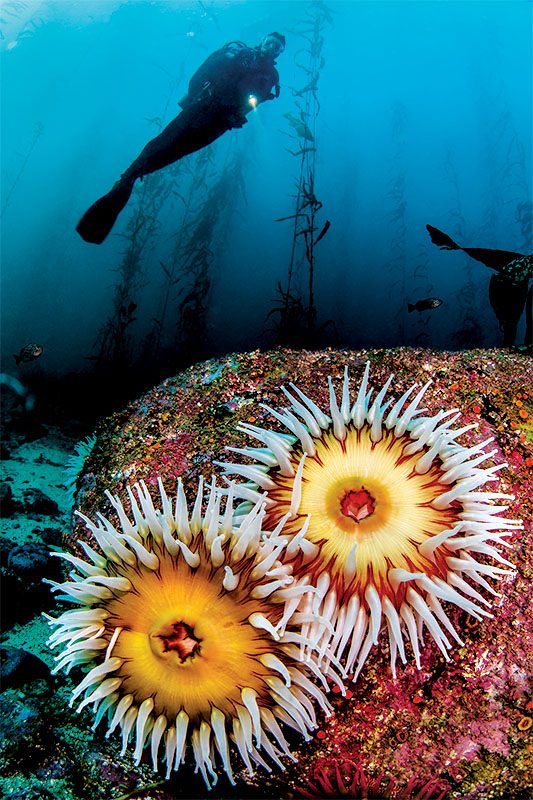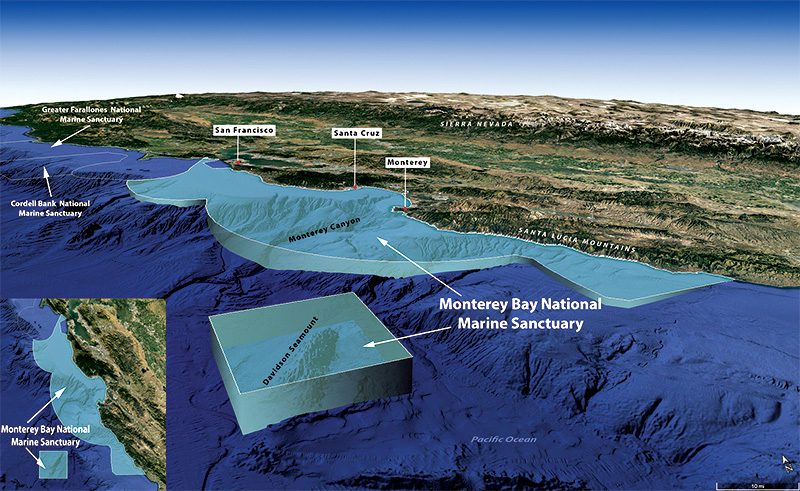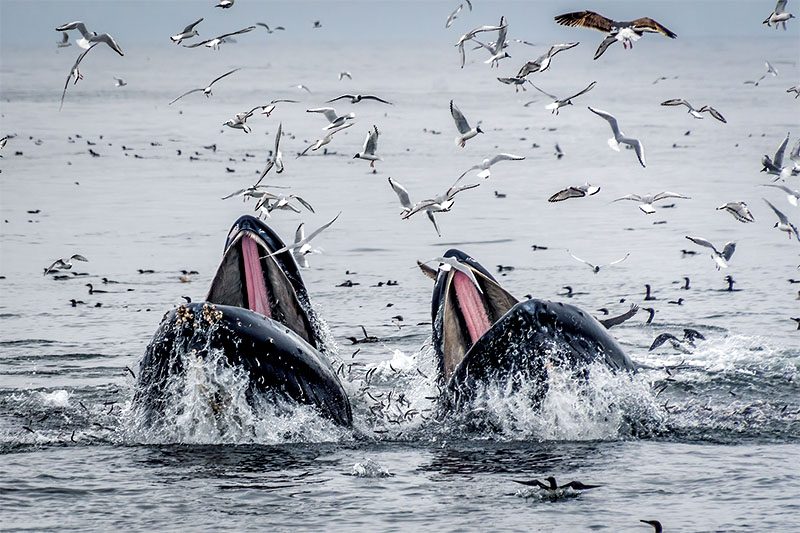Serengeti Laut Berusia 30 Tahun
Within the geographical confines of the Monterey Bay National Marine Sanctuary (MBNMS) is one of the world’s most ecologically diverse coastal marine environments. The sanctuary boundary spans almost 6,000 square miles (15.540 square meters) and contains more than 276 miles (444 kilometers) of California shoreline.
A massive underwater canyon — deeper than the Grand Canyon and comparable in size and length — starts in the deep waters far beyond the sanctuary boundary and comes into the center of Monterey Bay. Every spring the wind blowing along the California coast stimulates the cold water to upwell from the deepwater canyon, pulling up nutrient-rich water from the darkness, exposing it to the sunlight, and depositing it into the heart of the bay.
Proses ini memicu ledakan makanan dalam rantai makanan, menyebabkan spesies berduyun-duyun datang ke wilayah ini dalam migrasi tahunan dan mengaduk-aduk ombak dalam kegilaan mencari makan bersama. Kawanan singa laut, lumba-lumba, dan paus yang menggeliat, dipadukan dengan burung-burung yang menyelam dari atas, menciptakan pemandangan yang sangat mengagumkan.
Dua puluh enam spesies yang secara federal diakui sebagai terancam atau hampir punah tinggal di atau bermigrasi ke suaka, yang ditarik dari tempat yang jauh oleh lebih dari sekadar arus pasang surut musim semi. Pada musim panas, penyu belimbing yang terancam punah tiba setelah menempuh perjalanan selama sembilan bulan, sejauh 7.000 mil (11.265 kilometer) dari pantai-pantai penelurannya di Indonesia. Setiap penyu di suaka ini menyantap hingga 50 ubur-ubur setiap harinya sebelum menyelesaikan siklus makan dan memulai migrasi pulang ke rumah selama hampir satu tahun untuk bertelur.
Seperti Taman Nasional Serengeti di Tanzania utara, yang terkenal sebagai tempat migrasi hewan darat tahunan terbesar di dunia, tidak mengherankan jika cagar alam Monterey Bay disebut sebagai rekan akuatiknya karena jumlah dan keanekaragaman hewan yang dapat Anda lihat di teluk ini pada hari tertentu.
Sekarang menjadi tempat di mana kehidupan laut dan manusia dapat hidup berdampingan, MBNMS memberi kita kesempatan untuk mengekang naluri alamiah kita untuk mendominasi dan mengkonsumsi lingkungan di sekitar kita. Namun, untuk wilayah AS ini, pola pikir tersebut tidak selalu demikian.
Sejarah Teluk Monterey dan garis pantai yang berdekatan adalah sejarah eksploitasi lingkungan oleh manusia. Demam emas tahun 1849 mengantarkan migrasi besar-besaran para penambang yang siap membongkar lereng-lereng bukit untuk mencari logam mulia tersebut. Banyak dari mereka yang gagal kemudian terjun ke perdagangan bulu, menjebak berang-berang laut untuk diambil bulunya, sementara yang lain mengejar anjing laut gajah untuk diambil bulunya. Kedua spesies ini hampir punah dalam prosesnya.
Kemudian ada juga yang menjelajah ke perairan yang lebih dalam untuk mengejar paus, yang minyaknya menjadi sumber energi pada masa itu. Setahun setelah perburuan emas dimulai, industri perburuan paus komersial dimulai di Monterey, dengan stasiun perburuan paus yang tersebar di sepanjang pesisir pantai hingga tahun 1921. Penduduk pesisir akan berduyun-duyun ke pantai untuk menyaksikan para pemburu paus ditarik bolak-balik melintasi teluk oleh makhluk laut dalam yang ditombak, saat mereka berusaha dengan sia-sia melarikan diri dari para pengejarnya.

The coastal region’s seemingly limitless bounty proved otherwise when the otters, sea lions, and whales disappeared, and the bay became a watery desert. Residents simply moved on to the next marine economy: harvesting giant California red abalone, the world’s largest abalone species. A year before the last whaling station closed, nine different abalone companies operated along the current sanctuary’s coastline, gathering abalone all day and shipping it worldwide.
When the abalone supply dwindled, the sardine industry exploded, leading to the region’s famed Cannery Row and Monterey becoming known as the sardine capital of the world. But that title lasted for only a few years. In the late 1940s the local industry collapsed when the sardine bounty was exhausted. This, in conjunction with the 1969 Santa Barbara oil spill that occurred approximately 250 miles (402 kilometers) down the coast, made many residents realize the impact of different industries on the local ecology.
Ketika para politisi dan eksekutif industri minyak mengarahkan pandangan mereka ke Teluk Monterey untuk eksplorasi dan ekstraksi minyak, gas, dan mineral, upaya konservasi yang hanya ada di tingkat akar rumput selama beberapa dekade mulai tumbuh secara eksponensial. Masyarakat pesisir California Tengah bersatu dan, dengan kepemimpinan para politisi pahlawan lokal, membawa masalah ini ke Kongres setelah bertahun-tahun berjuang di legislatif. Upaya gabungan dari semua orang yang terlibat membantu Monterey Bay mencapai status cagar alam laut nasional pada tahun 1992, yang telah dipegangnya selama 30 tahun.

Apa yang menjadi tempat perlindungan setelah 30 tahun ini?
Ini adalah kisah sukses konservasi. Since the establishment of MBNMS, the ecosystem has recovered and species populations have returned from their historically low levels and are continuing to thrive under strong protection efforts. With the preservation of public access to beaches and coastal waters, Monterey Bay is a place of social catalyst where people gather together — whether it’s beachgoers combing through rocky tide pools, surfers hitting the waves at the legendary Mavericks surf break, or scuba divers navigating through lush kelp forests, coral reefs, and canyon walls encrusted with colorful marine life.
Ini adalah tempat penemuan, such as the thousands of deepwater octopuses found laying their eggs 2 miles (3,2 kilometers) beneath the surface in the dark nooks and crannies of the Davidson Seamount area, which became part of the sanctuary in 2008. MBNMS has 463 reported shipwrecks within its waters — such as the legendary USS Macon airship and its yellow- and blue-winged Sparrowhawk biplanes sitting 1,500 feet (457 meters) below the surface — with more waiting to be discovered.
Ini adalah tempat ekonomi, where billions of dollars in revenue are generated each year. Once the whale-killing capital of California, Monterey Bay is now the whale-watching capital, generating more money than whale-hunting ever did. Fisheries for abalone and sardines still exist, and the bay is source to one of the world’s top markets for squid. Enforced regulations ensure that overfishing of the bay’s resources won’t occur again.
Ini adalah tempat ilmu pengetahuan, acting as a living laboratory for research to enhance our understanding of the oceans and to help us make informed management decisions. Eleven years after the 1987 outbreak of amnesic shellfish poisoning in humans in Canada, the Monterey Marine Mammal Center discovered the domoic acid toxin in the sanctuary’s sea lions, which consume the same fish harvested by people in the bay. They created a reporting chain for public health officials to help map toxin outbreaks and close harvesting locations. When animals are identified with the toxin, fisheries in the affected areas can be regulated by ramping up testing followed by preventative measures.

Ini adalah tempat yang semakin memprihatinkan. The marine sanctuary encompasses no dry ground, with the shoreward boundary extending no further inland than the mean high-tide line. The coastline of the sanctuary is vast, encompassing dense urban zones and four major shipping ports frequented by international vessels. Approximately 8 million people live within 50 miles (80,5 kilometers) of the sanctuary shoreline, and thousands of square miles of coastal watersheds adjacent to the sanctuary drain waste disposal directly into the sanctuary’s wetlands and marine waters.
Plastic concentrations in the water exist at varying densities at all levels in the water column, from the surface all the way down to 1,000 meters. A 2022 Stanford University study suggests that blue and humpback whales in the Monterey sanctuary may eat 10 million pieces of microplastics — as much as 95 pounds (43 kilograms) — per day. The data is so new that researchers are still uncertain of the future effects on whales and people, but the ramifications of plastic in the ocean have historically been less than ideal for marine animals.
MBNMS lebih dari sekadar benteng lingkungan. MBNMS menjadi model keberhasilan cagar alam bagi AS dan menginspirasi upaya konservasi laut di seluruh dunia. Tiga puluh tahun sebagai cagar alam laut nasional merupakan sebuah kemenangan, tetapi ini hanyalah permulaan jika dibandingkan dengan hampir dua abad dampak negatif manusia terhadap perairan di dalam batas-batasnya. Beberapa orang percaya bahwa cagar alam ini sekarang berada dalam kondisi yang paling rentan, tidak hanya karena dampak yang dipelajari dari manusia terhadap lingkungan, tetapi juga karena rasa perlindungan yang salah untuk selamanya tanpa perlu tindakan lebih lanjut.
Diperlukan upaya manusia yang abadi untuk mempertahankan makna nama tersebut tempat perlindungan yang ingin disampaikan. Ancaman terhadap cagar alam selalu ada di depan mata dalam bentuk perubahan iklim, pembangunan pesisir, polusi, dan kebutuhan energi. MBNMS membutuhkan pendanaan dan dukungan yang berkelanjutan agar dapat terus melestarikan dan melindungi sumber daya alam dan budaya serta kualitas laut dan daerah muara di dalam wilayahnya.
Jelajahi Lebih Lanjut
Untuk mendukung upaya pelestarian Cagar Alam Laut Nasional Teluk Monterey, kunjungi montereybayfoundation.org
Lihat lebih banyak lagi tentang Teluk Monterey dalam webcam langsung ini.
https://elephantseal.org/live-view/
© Penyelam Siaga - Q1 2023